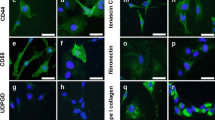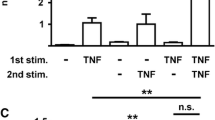Abstract:
Objectives and Design: The difference in cell proliferation and release of soluble factors in response to interleukin 1β (IL-1β) in fibroblasts obtained from patients with osteoarthritis (OA) and rheumatoid arthritis (RA) and from normal skin has been investigated.¶Treatment: The cells were treated with recombinant IL-1β in the presence or absence of pharmacological agents for 24 h or 48 h.¶Methods: Cell proliferation was examined by WST-1 assay, and the amounts of interleukin-6 (IL-6), interleukin-8 (IL-8), macrophage colony stimulating factor (M-CSF), vascular endothelial growth factor (VEGF), matrix metalloproteinase-1 (MMP-1), and prostaglandin E2 (PGE2) were measured by enzyme linked immunosorbent assay (ELISA).¶Results: IL-1β dose-dependently enhanced the proliferation of all fibroblasts. The proliferative response to IL-1β in RA synovial fibroblasts was greater than that in OA synovial and skin fibroblasts. However, there was no difference in spontaneous levels of soluble factors between OA and RA fibroblasts, though medium concentrations of IL-1β-released VEGF, MMP-1, and PGE2, but not cytokines, in RA were slightly higher than those in OA. Ability to release soluble mediators was pronouncedly increased at 3 h to 9 h after stimulating fibroblasts with IL-1β for 1h. The proliferative response to IL-1β in all fibroblasts was inhibited by dexamethasone and the NF-κB inhibitor hymenialdisine but not the cyclooxygenase 2 (COX-2) inhibitor NS-398. But PGE2 prevented proliferation of RA fibroblasts when added to medium up to 3 h after IL-1β stimulation. Dexamethasone also inhibited the release of IL-6, IL-8, and PGE2 induced by IL-1β in both OA and RA fibroblasts. NS-398 exhibited an inhibition of IL-1β-induced IL-6 production as well as PGE2 production. Hymenialdisine inhibited IL-6 production and reduced IL-8 production dependent on synovial cell strains. Methotrexate had no effect on the response to IL-1β in synovial fibroblasts.¶Conclusion: The present results indicate that the activation of NF-κB plays an important role in the proliferative response to IL-1β in human fibroblasts, and suggest that PGE2 acts as a modulator of cell proliferation in inflamed synovial tissue. It appears that the ability to produce soluble factors in RA synovial fibroblasts is not intrinsic. However, the response to IL-1β in RA cells seems to be greater than that in OA cells.¶
Similar content being viewed by others
Author information
Authors and Affiliations
Additional information
Received 4 May 2000; returned for revision 23 May 2000; accepted by W.B. van den Berg 22 August 2000
Rights and permissions
About this article
Cite this article
Inoue, H., Takamori, M., Nagata, N. et al. An investigation of cell proliferation and soluble mediators induced by interleukin 1β in human synovial fibroblasts: comparative response in osteoarthritis and rheumatoid arthritis. Inflamm. res. 50, 65–72 (2001). https://doi.org/10.1007/s000110050726
Issue Date:
DOI: https://doi.org/10.1007/s000110050726




